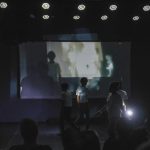On October 14-31, 2018, Prashasti Wilujeng Putri participated in a residency in the Lapuak-Lapuak Dikajangi # 2 – Silek art project held by Gubuak Kopi Community in Solok City, West Sumatra. Lapuak-Lapuak Dikajangi was an event of tradition preservation study activities through a multimedia platform. This year, Lapuak-Lapuak Dikajangi took the theme “Silek”. Prashasti and eight other artists were expected to collaborate in discussing “silek”–martial arts owned by the Minangkabau community–with current readings, understanding it in the present context, and responding to it with various mediums.
During their residency Prashasti discussed with some West Sumatran cultural observers, artists, silek teachers, and academics to understand more about silek, especially Silek Minang. Prashasti also visited several silek sasaran (or silek institution) in several areas around the city of Solok to see the practice of silek nowadays. In the midst of the residency, Prashasti, along with Ragil (member of 69 Performance Club) were also asked to participate in Ota Kadai, a bi-weekly discussion program managed by the Fine Arts Student Association of Padang State University. During the discussion, they discussed the performance art study process at 69 Performance Club, and the development of performance art in Jakarta and Padang today. Also, they also gave performance art workshops to Untempang Club, a multimedia study group initiated by Gubuak Kopi, with six members from SMAN (State Senior High School) 1 Solok. Their work will be presented on November 1-4, 2018 at the Solok City Learning Activities Studio.
Working Process:


Work Description:
For me, someone who is not close to the martial arts culture, understands that the fighter or pasilek has been described as a great hero with all his martial abilities. However, after learning it, I know that silek covers all human life. Pasilek is not meaningful when s/he is away from the community. In this work, the bodies of the audience were captured into the image captured by the pasilek, and the pasilek body becomes not singular in the images captured by the audience’s cameras. The images that represent the eyes of the audience and the eyes pasilek himself produce lines, fields, textures, and rhythms, and that is an attempt to frame the idea that “becoming a pasilek does not mean being sole and wallping, yet being small, numerous, and popular.”
Pasilek: Uda Eko
Sasaran Silek Limbago Budi
Installation:

Documentation:
Gubuak Kopi – http://gubuakkopi.id/lapuak-lapuak-dikajangi-2018/





